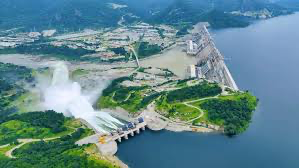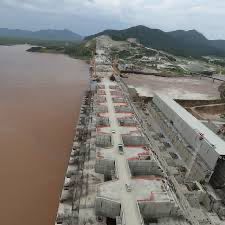By Befikadu Eba
Look at the Great Ethiopian Renaissance Dam (GERD) and you see an awe-inspiring feat of
engineering: millions of cubic meters of concrete, vast stretches of steel, and the mighty Blue Nile
being gently guided into a reservoir of immense potential. But if you look closer, you will see
something far more profound. You will see the fingerprints of a farmer from the highlands of
Gojam who bought a bond with a month’s savings, the solemn pledge of a taxi driver in Addis
Ababa who saw his contribution in every bag of cement, and the unwavering dream of a nation
and its successive leaders that bet unflinchingly on its own people. This dam is unlike any other
mega-project in the world for one simple, revolutionary reason: it is quite literally built by
Ethiopia, for Ethiopia, funded by Ethiopia. And that is what makes its economic and symbolic
promise so potent, so sweet, and so uniquely African.
The story of the GERD is not one that began with the first pour of concrete in 2011. It began as a
century-old dream, a whispered promise of a future electrified and self-determined. For
generations, Ethiopia watched its greatest natural resource, the Blue Nile, flow out of its borders
to power the development of others while its own people lived in energy poverty. The dream was
audacious, seemingly impossible for a nation often characterized by external narratives of need.

How do you pay for a dream this big? The answer, revolutionary in its simplicity and power, came
not from the conditional loans of foreign boardrooms or the dictates of international financial
institutions, but from the pockets, the hearts, and the indomitable will of everyday Ethiopians.
This was the genesis of a funding model that would become a masterclass in national mobilization.
Through innovative bond purchases and passionate national campaigns that echoed from the
bustling streets of Addis Ababa to the most remote woredas, the dam became ours. It was funded
by the civil servant who proudly diverted a portion of her salary, the diaspora community that sent
its pledges home as acts of patriotic love, and the local business owner who invested not for
immediate profit, but for the future of his grandchildren. This wasn’t just fundraising; it was a
nationwide sacrament of belief, a collective act of faith that created a profound, unshakable sense
of ownership. It cemented the feeling that this isn’t just the government’s project, but our collective
inheritance and achievement.
This monumental endeavor stands as a testament to the visionary faith of Ethiopia’s successive
leaders who dared to champion this cause. It required a rare kind of political courage – one that
looked beyond electoral cycles and short-term gains to plant a tree whose shade future generations
would enjoy. These leaders, across administrations, made a conscious and strategic decision to
prioritize long-term sovereignty over short-term convenience. They resisted the immense pressure
and navigated complex geopolitical waters, all while keeping the faith that their people would rise
to the occasion. Their leadership was not in imposing a project from on high, but in articulating a
vision so compelling that it ignited a national spirit of contribution and sacrifice. They provided
the framework, but it was the people who provided the foundation, both financial and spiritual.
The economic ripple effects of that initial act of faith began long before the first turbine could spin.
The GERD was, from its inception, a powerhouse of national pride and an engine of practical skill
development. All those jobs created during its construction – the thousands of engineers, welders,
laborers, electricians, and support staff – were jobs funded by our own collective commitment. The
skills they learned, the technical expertise they gained in project management, logistics, and
cutting-edge construction techniques, is a permanent human capital asset that now belongs to

Ethiopia. We didn’t just build a dam; we built the most advanced, large-scale training ground
imaginable, forging a generation of world-class engineers and project managers whose talent is
now a new, exportable national resource, ready to build the next great African infrastructure
project.
And now, as the power flows, the beautiful, virtuous economic circle is complete. The electricity
generated isn’t just powering homes and lighting up streets; it is powering the very
industrialization that we, as a nation, prepaid for with our faith. Every kilowatt-hour sold to a new
textile factory in Hawassa, a manufacturing plant in Adama, or a tech startup in Addis Ababa is a
direct return on our collective investment. The revenue it generates stays here, entirely within our
borders, to be reinvested in our communities, our schools, our hospitals, and our roads. Critically,
because there are no foreign loans to repay for the project’s core funding, the financial benefits
can circulate, multiply, and compound entirely within the Ethiopian economy, creating a powerful
multiplier effect that boosts our GDP in a way that truly and wholly benefits the very people who
made it possible.
The GERD’s lesson for Africa is not merely about hydroelectric engineering; it is a profound
lesson in political and economic agency. For too long, Africa’s development narrative has been
written by others, often accompanied by financing strings that perpetuate dependency and often
fail to align with true national priorities. The GERD presents a radical alternative: the philosophy
of endogenous development. It proves that the most valuable resource any country has isn’t just
water, minerals, or oil – it is the unity, determination, and intellectual capital of its people. It
demonstrates that with visionary leadership that trusts its citizens, and a citizenry that trusts in its
leadership, the impossible becomes inevitable.
This model of internally financed, nationally owned development is a beacon for the continent.
Imagine an Africa where mega-projects are not debt traps that mortgage a nation’s future to foreign
creditors, but are instead vehicles for domestic investment, skill development, and national pride.
The GERD blueprint shows that it is possible. It requires transparency to build trust, relentless
communication to build solidarity, and the courage to start small, with the conviction that many
small contributions, pooled together, can move mountains – or dam great rivers.
The Great Ethiopian Renaissance Dam is therefore more than a source of clean energy; it is our
national promise to ourselves, paid in full. It is a covenant between the government and the
governed, a proof of concept that when a nation unites around a common, visionary goal, there is
no limit to what it can achieve. It is a monument to the fact that the greatest dams we must build
are not those made of concrete, but those built against the currents of doubt and dependency. The
GERD stands as Ethiopia’s gift to its future and a powerful lesson to Africa: that true development
is not given, but built – by us, for us.
Befikadu Eba is founder and managing director of Erudite Africa Investments, a former Banker
with strong interests in Economics, private sector development and financial inclusion. He is
reachable at befikadu.eba@eruditeafrica.com.